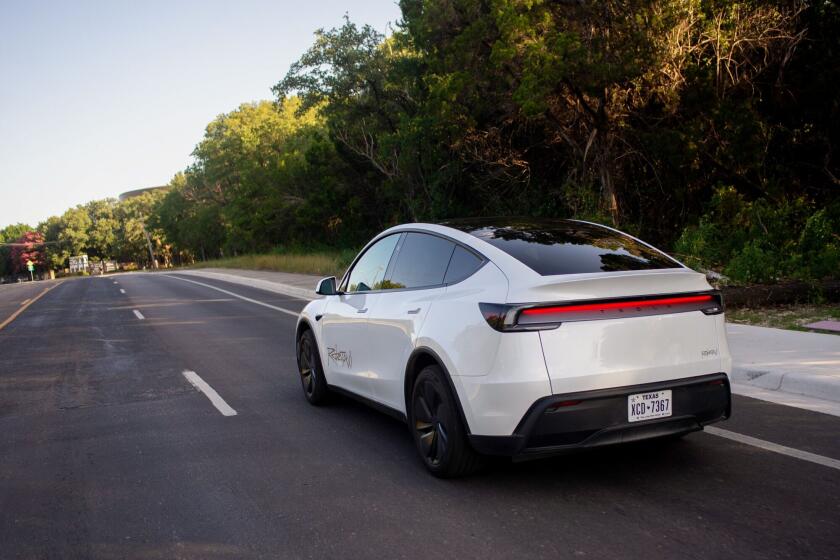Costs, Benefits of Metro Green Line Rail Project
- Share via
Thank you for featuring the Metro Green Line Light Rail project in the Los Angeles Times South Bay edition of Oct. 8, 1993.
I was pleased to read the transportation article by Gordon Dillow during Rideshare Week; however, The Times missed a great opportunity to provide information and to educate its readers about the importance of having alternative modes of transportation within the region. The article could have highlighted the Metropolitan Transportation Authority’s work in the region to provide these alternatives that will eventually help improve the general quality of life in the region. Once built, the various rail projects, including the Metro Green Line, will contribute to improving our air quality and quality of life by reducing smog, lessening freeway congestion and reducing individual commuter stress and wasted time.
Instead, The Times article focused on the cost of constructing the Green Line Light Rail project. The reporter inappropriately compared costs for a project that has changed and evolved dramatically from its inception--when freeway planners suggested reserving the median of the new freeway for a busway--to today’s 20-mile, high-performance, state-of-the-art light rail system that includes an elevated trackway into the El Segundo employment area. The fact is, $722.4 million to build a 20-mile, fully grade separated light rail system with 14 stations and 6,000 park-and-ride spaces is the bargain of the century.
The article failed to include information explaining:
* The project status at 70% complete.
* The special artwork for each station, especially those stations in El Segundo.
* Track has been laid on 13 of the 17 miles of freeway median.
* The Hawthorne Yards and Shops is 64% complete.
* The Metro Green Line continues to be one of the safest transit construction projects in the nation.
Costs and budgets are important to construction projects but must be presented in the appropriate context. The Metro Green Line will be on an isolated track-bed along the median of a modern freeway with an elevated extension to serve the South Bay communities of El Segundo, Hawthorne, Manhattan Beach and Redondo Beach. The system is being built with an Automated Train Control system to facilitate future fully automated operation. Additionally, the project will have its own full-service maintenance yard and carwash facility.
The SkyTrain system in Vancouver, British Columbia, Canada, is the closest comparable driverless automated train system at 21.4 kilometers, or 13.3 miles, with 15 stations, which travels on an isolated elevated guideway, powered by a third-rail system. The SkyTrain system’s final cost was nearly $60 million a mile (in 1993 dollars) to build, while the cost of the Metro Green Line is approximately $36 million per mile. With regard to schedule, five years to build a 20-mile, fully grade separated, high-performance, state-of-the-art light rail vehicle transit system is well within industry standards. The project’s construction team is committed to improving on the schedule wherever possible.
The local aerospace industry has been affected by the downturn in federal defense contracts. Some have closed or moved out of the area. Nonetheless, the local chambers of commerce have initiated efforts to attract new business to their cities by promoting easy commutes by either the new freeway or the Green Line. We expect Green ridership will include employees from the major El Segundo employers--TRW, Northrop, Hughes, small businesses in the area, LAX hotel employees and travelers using LAX.
Regardless of the current economic climate, the El Segundo area will be an extremely attractive location for business because of its excellent transportation assets--LAX, the I-105 freeway and the new Metro Green line. In fact, with the opening of I-105 freeway, commuters can see for themselves construction of the Green line, which runs down the center median of the freeway. Ridership will also be enhanced by riders transferring from the Metro Blue Line that runs between downtown Los Angeles and Long Beach. These will be the major benefactors of the Green Line.
Again, thank you for your interest in the Metropolitan Transportation Authority’s efforts to improve mobility for the residents of the greater Los Angeles area. Please continue to support our efforts and help your readers to appreciate what we are building to improve transit in the region.
ED McSPEDON
MTA executive officer, construction, and president, Rail Construction Corp.
More to Read
Sign up for Essential California
The most important California stories and recommendations in your inbox every morning.
You may occasionally receive promotional content from the Los Angeles Times.













